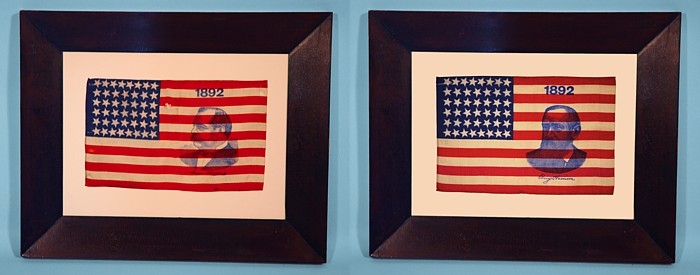
| |
MATCHING PAIR OF PRINTED SILK PORTRAIT FLAGS FROM THE 1892 PRESIDENTIAL RACE OF GROVER CLEVELAND VS. BENJAMIN HARRISON |
|
| Available: |
Sold |
| Frame Size (H x L): |
14.5" x 18" (each) |
| Flag Size (H x L): |
Clevelnad: 6.75" x 10.5", Harrison: 6.5" x 10.5" |
|
| Description....: |
|
MATCHING PAIR OF PRINTED SILK PORTRAIT FLAGS FROM THE 1892 PRESIDENTIAL RACE OF GROVER CLEVELAND VS. BENJAMIN HARRISON:
Printed on silk, this beautiful pair of 44 star parade flags was embellished with respectively large portraits of the Democrat and Republican candidates for the U.S. presidency, Grover Cleveland and Benjamin Harrison. Below each man is a replication of his signature, and above is the corresponding 1892 date of the presidential election.
Examples of each flag is in the collection of the Smithsonian and each is documented in "Threads of History: Americana Recorded on Cloth, 1775 to the Present", by Herbert Ridgeway Collins, Smithsonian Press, 1979 (items 714 and 715, pgs. 297 and 298). This is the best text on American political textiles. Collins formerly served as Curator of Political History at the Smithsonian Institution. Examples also exist in the collection of Richard Pierce and are documented in his book "The Stars & Stripes: Fabric of American Spirit", J Richard Pierce, LLC, 2005 (pg. 53).
The flags are somewhat unusual among portrait examples, because the images are printed in the same blue ink as the cantons. Parade flags were more often overprinted in black ink with political advertising. Unlike some campaign parade flags, these 44 star examples exist without the portraits and text. In fact, plain 44 star parade flags in this style and size can be found on their own, tacked to a staff, or found inside political and patriotic canes that come apart to reveal a hidden parade flag inside. They were available in several sizes, although this, the smallest size, is the only one I have ever seen with political campaign overprints. Two other, non-political advertising flags are known in the same form and size, but they instead have black, overprinted text. One is a salesman's sample, made by the manufacturer to demonstrate what could be done with text in the stripe area to advertise businesses or events. The other was made to commemorate the 100th performance of an actor. Both are in the collection of Richard Pierce.
The Cleveland example is much rarer than the Harrison and while I see several Harrison examples each year, I have rarely encountered the Cleveland example in the marketplace.
1892 marked the third time that Grover Cleveland would run for president. Having won in 1884 and lost in 1888, he became the only man to serve two non-consecutive terms when he won again in 1892. He was the only president to get married in the Whitehouse. In 1886, at age 56, Cleveland married his 22-year old ward, the daughter of his former business partner, who subsequently bore him five children. A Democrat who appealed to moderate Republicans, Cleveland had first served public office as a local sheriff, then as Mayor of Buffalo, and finally Governor of New York. He was an imposing, five-foot eleven, two-hundred-sixty-pound man who was thought of as a "regular Joe".
By contrast, his Republican opponent, Benjamin Harrison, was just five feet, six inches tall. Democrats called him "Little Ben", yet supporters replied that he was big enough to wear the hat of his grandfather, William Henry Harrison, the ninth President of the United States and Hero of Tippecanoe. Born in Ohio, Harrison studied law in Cincinnati before moving to Indiana, where he set up a very successful practice. During the Civil War he served his new state in command of the 70th Volunteer Infantry. He was brevetted brigadier general before the war's end and was afterwards very active in the G.A.R and a strong proponent of veteran's matters. He was elected to the U.S. Senate, where he served from 1881 to 1887.
Harrison had defeated Cleveland in 1888, in an election that focused mostly on the economics of free trade. In that year Cleveland adhered to tradition and refused to campaign as the incumbent president, a move that may have cost him the election. In 1892, many of the same issues were popular, but this time Cleveland did campaign and won handily.
Mounting: The flags have each been hand-stitched to 100% cotton rag mat and placed in matching frames that date to the period between 1830 and 1860 and have tremendous early surface. Spacers keep the textiles away from the glass, which is u.v. protective.
Condition: There are minor stains and losses, but the colors are strong and there are no serious condition issues. |
|
|
|
| Collector Level: |
Advanced Collectors and the Person with Everything |
|
| Flag Type: |
Parade flag |
|
| Star Count: |
44 |
|
| Earliest Date of Origin: |
1892 |
|
| Latest Date of Origin: |
1892 |
|
| State/Affiliation: |
Wyoming |
|
| War Association: |
1866-1889 Indian Wars |
|
| Price: |
Sold |
|
| |
Views: 3722 |
|
|
|

